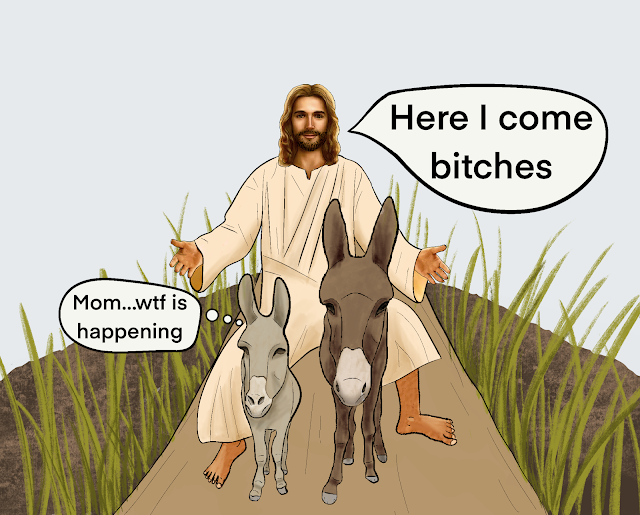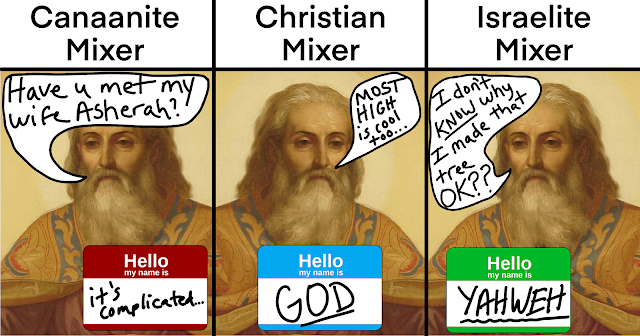Did Jesus ride two donkeys into Jerusalem?
Many are familiar with the story of Jesus riding majestically into Jerusalem on a donkey during the Triumphal Entry. What you MAY not know is that in the gospel of Matthew, Jesus rides into town on TWO DONKEYS.
Count 'em: two. A mother donkey and her colt.
It's unclear how Jesus was able to physically ride on two donkeys at once, especially when they were two different sizes. Maybe something like this:
 |
| The most plausible donkey configuration...another possibility is to ride them like water skis |
But this little bit of weirdness in Matthew's gospel is overwhelming evidence that the anonymous author of Matthew was INVENTING fiction in order to fulfill Old Testament prophecy--or at least, what he UNDERSTOOD to be OT prophecy.
In order for fulfilled prophecy to be actually compelling, it has to be something like this:
- Prophecy is written down
- Events actually happen that fulfill the prophecy
- Documentation is written about the events
- Prophecy is written in Zechariah 9:9 in Hebrew
- Hebrew is translated into Greek but not correctly
- <prophesied events did not happen>
- Matthew further misinterprets the Greek translation of Zechariah 9:9, writes a story to fulfill the misinterpreted prophecy
- Matthew is forever haunted by his two donkey blunder
Rejoice greatly, O daughter of Sion; proclaim [it] aloud, O daughter of Jerusalem; behold, the King is coming to thee, just, and a Saviour; he is meek and riding on an ass, and a young foal.
Matthew even quotes this passage in his gospel (Mt 21:5) so we know without a doubt that this is the specific OT prophecy that he is attempting to fulfill. (Click here for full Matthew passage).
- The mistranslated conjunction word "and";
- Misinterpretation of a poetic structure called "parallelism"
The Conjunction Word "And"
In the Hebrew text of Zechariah 9:9, there is a short conjunction (joining word) between the two lines. This conjunction word can mean "and", "but", and "or", and sometimes the meaning is so insignificant that it is dropped entirely in translation. But in the Septuagint, this pesky word is translated as "AND". So the version of the scriptures that Matthew relied on (quoted above) implied that there were two separate animals, but the Hebrew version does not imply the meaning "AND" by the use of that conjunction.Parallelism
humble and mounted on a donkey,on a colt, the foal of a donkey.
The Bottom Line
So what does all this mean? Instead of describing events that actually happened, Matthew crafted a narrative based on his own understanding of a mistranslation of the original scriptures.
If Matthew had been recording actual events, or eyewitness accounts of them, or his own memory of them, then why would he be consulting the scriptures while he was writing? If there actually were a God directing events and fulfilling prophecy, then it would be irrelevant what the scriptures said or how they were translated. Nobody would need to rely on the scriptures to see what the prophecies were...GOD WOULD FULFILL THEM ON HIS OWN.
Which makes you wonder...what else in the New Testament was merely written to fulfill OT prophecy? Could it be...everything?
Matthew Chapter 21:1-8 NIV
Further watching and reading:
- Excavating the Empty Tomb Part 11a (YouTube)
- Greek/English side by side of Septuagint
- Dr. Bart Ehrman on Matthew's Two Donkeys (YouTube)
- New Testament Review on #StackedDonkeys (YouTube)


Comments
Post a Comment
Please leave a respectful and kind comment.